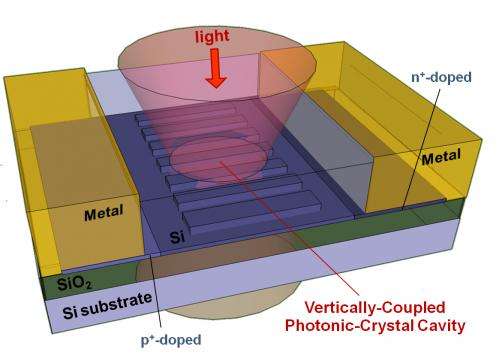Antenna-on-a-chip rips the light fantastic

(Phys.org)—A device that looks like a tiny washboard may clean the clocks of current commercial products used to manipulate infrared light.
New research by the Rice University lab of Qianfan Xu has produced a micron-scale spatial light modulator (SLM) like those used in sensing and imaging devices, but with the potential to run orders of magnitude faster. Unlike other devices in two-dimensional semiconducting chips, the Rice chips work in three-dimensional "free space."
Xu and his Rice colleagues detailed their antenna-on-a-chip for light modulation this week in Nature's open-access, online journal Scientific Reports.
The manipulation of light has become central to the information economy. Think about light-reflecting compact discs and their video variants and all the ways lasers are used, from sensing to security to surgery. Light carries data through optical fibers for telecommunications and signals on the molecular scale as photonics techniques improve. Light-emitting diodes power television displays (for viewers clutching infrared remotes) and are beginning to replace the inefficient light bulbs in homes.
But in the computer space, light has been bound and gagged by two-dimensional circuitry, tied to waveguides that move it from here to there, Xu said. He and his colleagues point out in the new paper that 2-D systems fail to take advantage of "the massive multiplexing capability of optics" made possible by the fact that "multiple light beams can propagate in the same space without affecting each other."
The researchers see great potential for free-space SLMs in imaging, display, holographic, measurement and remote sensing applications.

Simply put, the Rice team's microscopic SLM chips are nanoscale ribs of crystalline silicon that form a cavity sitting between positively and negatively doped silicon slabs connected to metallic electrodes. The positions of the ribs are subject to nanometer-scale "perturbations" and tune the resonating cavity to couple with incident light outside. That coupling pulls incident light into the cavity. Only infrared light passes through silicon, but once captured by the SLM, it can be manipulated as it passes through the chip to the other side. The electric field between the electrodes turns the transmission on and off at very high speeds.
Individual SLMs are analogous to pixels, and Xu, an assistant professor of electrical and computer engineering, sees the possibility of manufacturing chips that contain millions of them.
In conventional integrated photonics, "You have an array of pixels and you can change the transmission of each pixel at a very high speed," he said. "When you put that in the path of an optical beam, you can change either the intensity or the phase of the light that comes out the other side.
"LED screens are spatial light modulators; so are micromirror arrays in projectors, in which the mirrors rotate," he said. "Each pixel changes the intensity of light, and you see an image. So an SLM is one of the basic elements of optical systems, but their switching speed is limited; some can get down to microseconds, which is okay for displays and projection.
"But if you really want to do information processing, if you want to put data on each pixel, then that speed is not good enough." Xu said the Rice team's device "can potentially modulate a signal at more than 10 gigabits per second.
"What we show here is very different from what people have been doing," he said. "With this device, we can make very large arrays with high yield. Our device is based on silicon and can be fabricated in a commercial CMOS factory, and it can run at very high speed. We think this can basically scale up the capability of optical information processing systems by an order of several magnitudes."
As an example, he suggested the device could give the single-pixel camera in development at Rice – which at the beginning took eight hours to process an image – the ability to handle real-time video.
"Or you could have an array of a million pixels, and essentially have a million channels of data throughput in your system, with all this signal processing in parallel," he said. "If each pixel only runs at kilohertz speeds, you don't get much of an advantage compared with microelectronic systems. But if each pixel is working at the gigahertz level, it's a different story."
Though Xu's antennas would not be suitable for general computing, he said, they could be capable of optical processing tasks that are comparable in power to supercomputers. "Optical information processing is not very hot," he admitted. "It's not fast-developing right now like plasmonics, nanophotonics, those areas. But I hope our device can put some excitement back into that field."
More information: www.nature.com/srep/2012/12111 … /full/srep00855.html
Journal information: Scientific Reports , Nature
Provided by Rice University


















